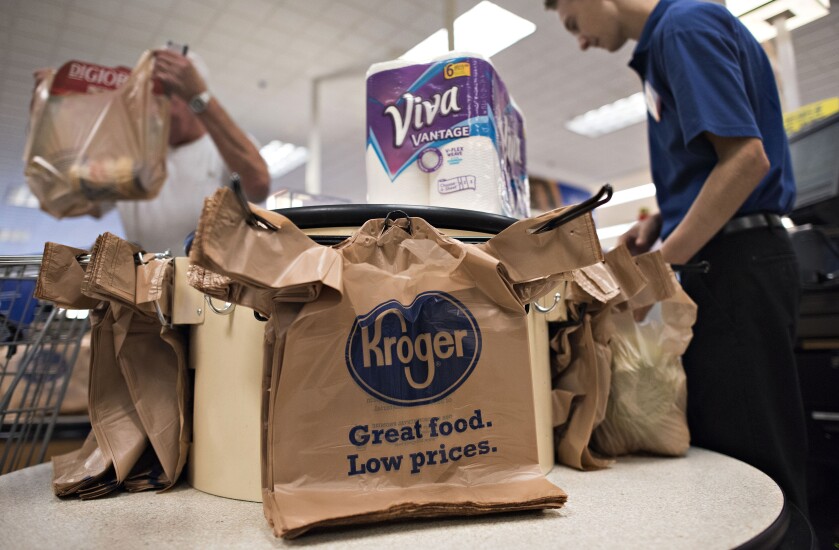

An idea that clicks
But it's not skimping on the personal touch. A store employee greets the shopper and helps load the groceries.
"ClickList makes it easier for customers to engage with us," said Kroger payments chief Kathy Hanna. "They are extremely busy and have children and parents, jobs, etc. The digital platform helps make the grocery experience a lot easier."
Consumers pay at the point of pickup, though Hanna said Kroger is developing an online payment option, which is already active in a few stores. "We want to make that smooth as it ties to our loyalty program," Hanna said.
The process gives Kroger an e-commerce feel at a time when grocery stores are accelerating their move online. As payments and grocery shopping give way to omnichannel order memory, the pressure's on for Kroger to stay ahead of the pace of innovation.

Multi-merchant rewards
In securing Southeastern Grocers LLC in March as its first grocery participant, Plenti now has a mix of basic life essentials to offer consumers through its gasoline, grocery, clothing and pharmacy retailers, among others.
Though Plenti still promises merchants
"We expect Southeastern Grocers will add significant scale and Plenti membership around the southeast," Berwitz said. "They have a strong and loyal customer base actively engaged in their loyalty programs."
The Winn-Dixie, Harveys, BI-LO and Fresco y Mas grocery chains operate under the Southeastern Grocers umbrella.
"The grocery category in the U.S. is highly regionalized, and Plenti expects to expand the coalition with new grocery partners over time in other regions across the country," Berwitz said. "We know many regional grocers are consistently evaluating loyalty and we believe our coalition model is especially appealing."

AmazonFresh
Even if these projects fizzle, they serve a purpose. Amazon needs to test and iterate in the wild rather than in a sterile environment such as a corporate campus. The e-tailer has the advantage of a blank canvas for designing the grocery store of the future, which may present a significant advantage in improving on the archaic model of pushing a heavily used cart through crowded grocery aisles.
However, there is a ritualistic nature to the weekly grocery shop and for the less tech savvy, Amazon may struggle to gain traction with the masses.
To spur adoption, Amazon is offering discounted Prime subscriptions to anyone with a valid Electronic Benefits Transfer card, lowering the barrier to buying groceries via AmazonFresh, which requires a Prime subscription.

Shipt shape
The Birmingham, Ala.-based company raised an additional $40 million in funding from previous backers Greycroft Partners, e.ventures and Harbert Venture Partners.
Unlike the AmazonFresh Pickup model, which lets customers set a time of their choosing to get their groceries from an Amazon location, Shipt suggests delivery windows and works with local grocery chains.
Shipt has an annual membership fee but does not charge a per-order fee.

Walmart's grocery experiments
Conceptually this initiative may be a stroke of genius, not unlike the Seinfeld
Even if that doesn't pan out, Walmart has other options. It is testing a system for using unmanned kiosks to deliver grocery orders.
Unlike Amazon or Shipt, the system doesn't restrict the window of pickup. The kiosk is available 24 hours a day, and customers retrieve their order by punching in a five-digit PIN. The kiosks are still in testing, and the service is free but requires a $30 minimum purchase, The Verge notes.

In the cards
Fortunately, Costco was on board with the strategy and in February began deploying compatible hardware at the point of sale.
Costco’s delay in introducing EMV isn’t surprising, given the challenges faced by many national retailers—especially
Citi, which says it’s experiencing

Faster food
The restaurant category is so important for Masterpass because purchase frequency means it could be a major “gateway” for consumers’ initial enrollment and ongoing usage of the digital wallet.
And Mastercard’s preferred method of enrolling consumers in Masterpass differs significantly from that of rival wallets like Visa and PayPal, which have users sign up via a website to link multiple cards.
Through its “digital by default” strategy, Mastercard directs consumers enrolling for the first time with Masterpass to link a card from their own bank from a list of financial institutions that support the digital wallet. Consumers may also enroll any payment card through the Masterpass website.
Mastercard expects to see more restaurants adding Masterpass in the coming months, as offering broader payments options becomes a competitive advantage.
“We want to feature payment methods that our consumers want to use for payment, but we’re still in the early stages of digital wallet adoption and will continue to evaluate other platforms and opportunities” said Scott Hudler, Dunkin’ Donuts’ chief digital officer.





